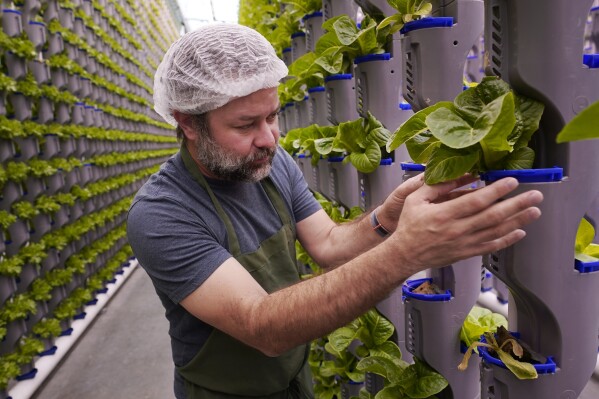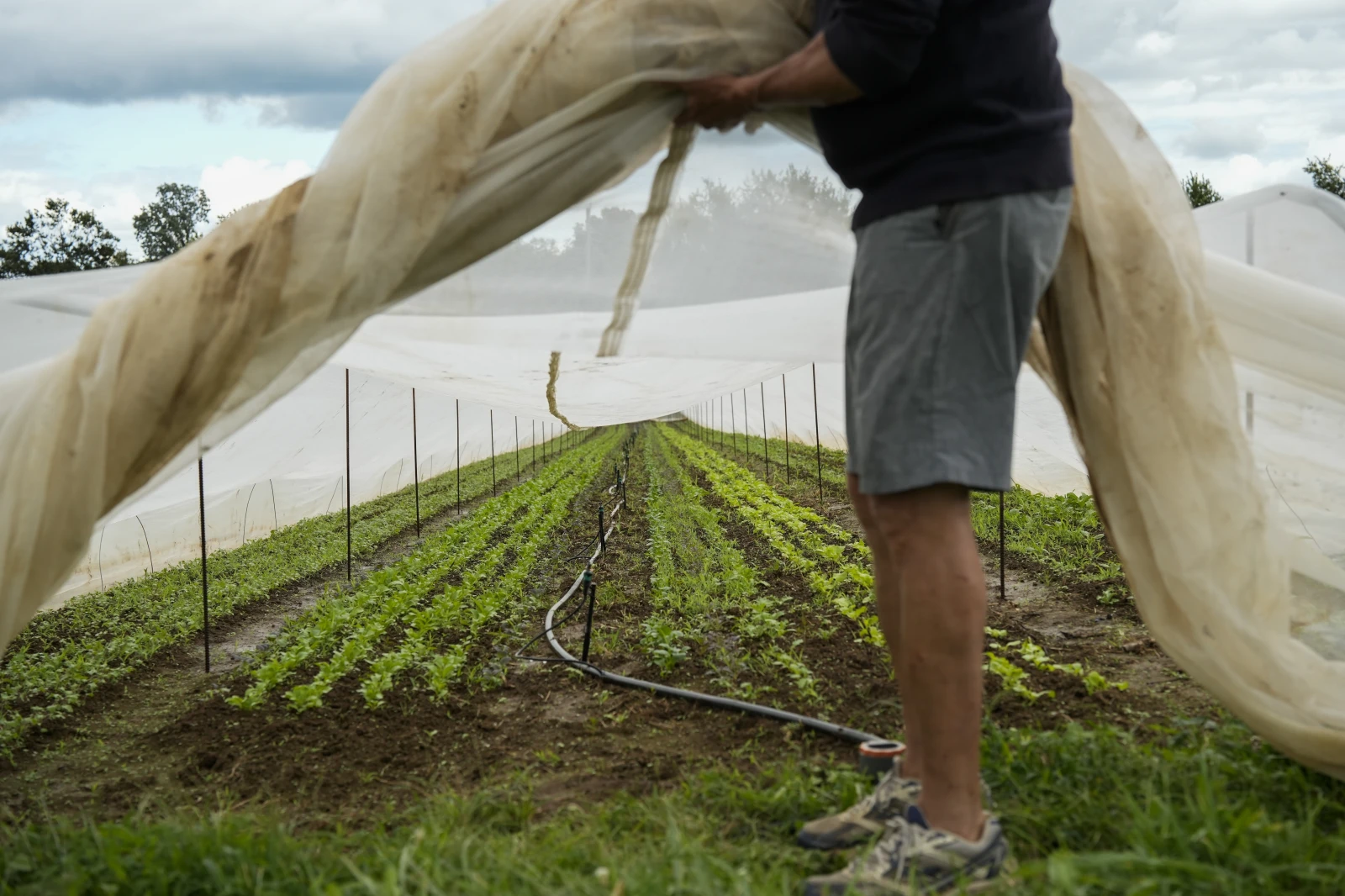Cliffs if you don't have time to read. Power costs are hurting this new industry.
Updated 8:44 PM EDT, September 17, 2023
Share
CLEBURNE, Texas (AP) — Inside a bright greenhouse about an hour outside Dallas, workers in hairnets and gloves place plugs of lettuce and other greens into small plastic containers — hundreds of thousands of them — that stack up to the ceiling. A few weeks later, once the vegetables grow to full size, they’ll be picked, packaged and shipped out to local shelves within 48 hours.
This is Eden Green Technology, one of the latest crop of indoor farming companies seeking their fortunes with green factories meant to pump out harvests of fresh produce all year long. The company operates two greenhouses and has broken ground on two more at its Cleburne campus, where the indoor facilities are meant to shelter their portion of the food supply from climate change while using less water and land.
But that’s if the concept works. And players in the industry are betting big even as rivals wobble and fail. California-based Plenty Unlimited this summer broke ground on a $300 million facility, while Kroger announced that it will be expanding its availability of vertically farmed produce. Meanwhile, two indoor farming companies that attracted strong startup money — New Jersey’s AeroFarms and Kentucky’s AppHarvest — filed for bankruptcy reorganization. And a five-year-old company in Detroit, Planted Detroit, shut its doors this summer, with the CEO citing financial problems just months after touting plans to open a second farm.

Aaron Fields looks at produce growing in vertical farm green house he manages at Eden Green Technology in Cleburne, Texas, Aug. 29, 2023. (AP Photo/LM Otero)
The industry churn doesn’t bother Jacob Portillo, a grower with Eden Green who directs a plant health team and monitors irrigation, nutrients and other factors related to crop needs.
“The fact that other people are failing and other people are succeeding, that’s going to happen in any industry you go to, but specifically for us, I think that especially as sustainable as we’re trying to be, the sustainable competitors I think are going to start winning,” he said.
Indoor farming brings growing inside in what experts sometimes call “controlled environment agriculture.” There are different methods; vertical farming involves stacking produce from floor to ceiling, often under artificial lights and with the plants growing in nutrient-enriched water. Other growers are trying industrial-scale greenhouses, indoor beds of soil in massive warehouses and special robots to mechanize parts of the farming process.
Advocates say growing indoors uses less water and land and allows food to be grown closer to consumers, saving on transport. It’s also a way to protect crops from increasingly extreme weather caused by climate change. The companies frequently tout their products as free of pesticides, though they’re not typically marketed as organic.
But skeptics question the sustainability of operations that can require energy-intensive artificial light. And they say paying for that light can make profitability impossible.

Tom Kimmerer, plant physiologist, poses for a portrait, Tuesday, Aug. 15, 2023, at Elmwood Stock Farm in Georgetown, Ky. (AP Photo/Joshua A. Bickel)

Mac Stone lifts the netting on a hoop house to reveal rows of lettuce underneath, Tuesday, Aug. 15, 2023, at Elmwood Stock Farm in Georgetown, Ky. (AP Photo/Joshua A. Bickel)
Tom Kimmerer, a plant physiologist who taught at the University of Kentucky, has tracked indoor farming alongside his research into the growth of plants both outdoors and inside. He said his first thought on vertical farm startups — especially those heavily reliant on artificial light — was, “Boy, this is a dumb idea” — mainly due to high energy costs.
The industry has acknowledged those high costs. Some companies are seeking to push those down by relying on solar, which they say also supports sustainability. Even the ones most heavily reliant on artificial light that doesn’t come from renewables maintain they can be profitable by eventually producing a high volume of produce year-round.
But Kimmerer thinks there are better ways to provide food locally and extend the growing season — outdoors. He pointed to the organic farmstand-oriented Elmwood Stock Farm outside Lexington, Kentucky, which can grow tomatoes and greens the whole year using tools like high tunnels, also known as hoop houses — greenhouse-like arches that shelter crops while still being partially open to the outdoors.

Tomato plants grow inside a hoop house, Tuesday, Aug. 15, 2023, at Elmwood Stock Farm in Georgetown, Ky. (AP Photo/Joshua A. Bickel)
Lots of indoor farms are shutting down as their businesses struggle. So why are more being built?
BY MELINA WALLING AND KENDRIA LAFLEURUpdated 8:44 PM EDT, September 17, 2023
Share
CLEBURNE, Texas (AP) — Inside a bright greenhouse about an hour outside Dallas, workers in hairnets and gloves place plugs of lettuce and other greens into small plastic containers — hundreds of thousands of them — that stack up to the ceiling. A few weeks later, once the vegetables grow to full size, they’ll be picked, packaged and shipped out to local shelves within 48 hours.
This is Eden Green Technology, one of the latest crop of indoor farming companies seeking their fortunes with green factories meant to pump out harvests of fresh produce all year long. The company operates two greenhouses and has broken ground on two more at its Cleburne campus, where the indoor facilities are meant to shelter their portion of the food supply from climate change while using less water and land.
But that’s if the concept works. And players in the industry are betting big even as rivals wobble and fail. California-based Plenty Unlimited this summer broke ground on a $300 million facility, while Kroger announced that it will be expanding its availability of vertically farmed produce. Meanwhile, two indoor farming companies that attracted strong startup money — New Jersey’s AeroFarms and Kentucky’s AppHarvest — filed for bankruptcy reorganization. And a five-year-old company in Detroit, Planted Detroit, shut its doors this summer, with the CEO citing financial problems just months after touting plans to open a second farm.
Aaron Fields looks at produce growing in vertical farm green house he manages at Eden Green Technology in Cleburne, Texas, Aug. 29, 2023. (AP Photo/LM Otero)
The industry churn doesn’t bother Jacob Portillo, a grower with Eden Green who directs a plant health team and monitors irrigation, nutrients and other factors related to crop needs.
“The fact that other people are failing and other people are succeeding, that’s going to happen in any industry you go to, but specifically for us, I think that especially as sustainable as we’re trying to be, the sustainable competitors I think are going to start winning,” he said.
Indoor farming brings growing inside in what experts sometimes call “controlled environment agriculture.” There are different methods; vertical farming involves stacking produce from floor to ceiling, often under artificial lights and with the plants growing in nutrient-enriched water. Other growers are trying industrial-scale greenhouses, indoor beds of soil in massive warehouses and special robots to mechanize parts of the farming process.
Advocates say growing indoors uses less water and land and allows food to be grown closer to consumers, saving on transport. It’s also a way to protect crops from increasingly extreme weather caused by climate change. The companies frequently tout their products as free of pesticides, though they’re not typically marketed as organic.
But skeptics question the sustainability of operations that can require energy-intensive artificial light. And they say paying for that light can make profitability impossible.
Tom Kimmerer, plant physiologist, poses for a portrait, Tuesday, Aug. 15, 2023, at Elmwood Stock Farm in Georgetown, Ky. (AP Photo/Joshua A. Bickel)
Mac Stone lifts the netting on a hoop house to reveal rows of lettuce underneath, Tuesday, Aug. 15, 2023, at Elmwood Stock Farm in Georgetown, Ky. (AP Photo/Joshua A. Bickel)
Tom Kimmerer, a plant physiologist who taught at the University of Kentucky, has tracked indoor farming alongside his research into the growth of plants both outdoors and inside. He said his first thought on vertical farm startups — especially those heavily reliant on artificial light — was, “Boy, this is a dumb idea” — mainly due to high energy costs.
The industry has acknowledged those high costs. Some companies are seeking to push those down by relying on solar, which they say also supports sustainability. Even the ones most heavily reliant on artificial light that doesn’t come from renewables maintain they can be profitable by eventually producing a high volume of produce year-round.
But Kimmerer thinks there are better ways to provide food locally and extend the growing season — outdoors. He pointed to the organic farmstand-oriented Elmwood Stock Farm outside Lexington, Kentucky, which can grow tomatoes and greens the whole year using tools like high tunnels, also known as hoop houses — greenhouse-like arches that shelter crops while still being partially open to the outdoors.
Tomato plants grow inside a hoop house, Tuesday, Aug. 15, 2023, at Elmwood Stock Farm in Georgetown, Ky. (AP Photo/Joshua A. Bickel)